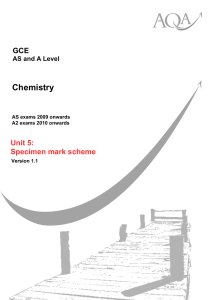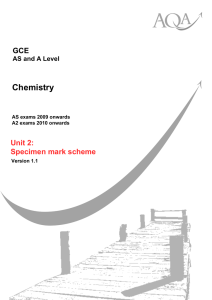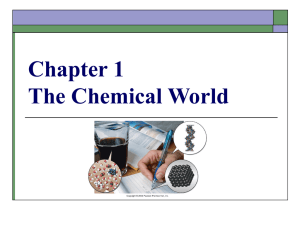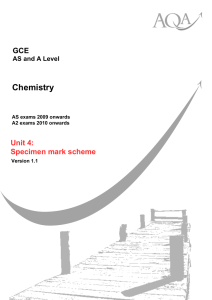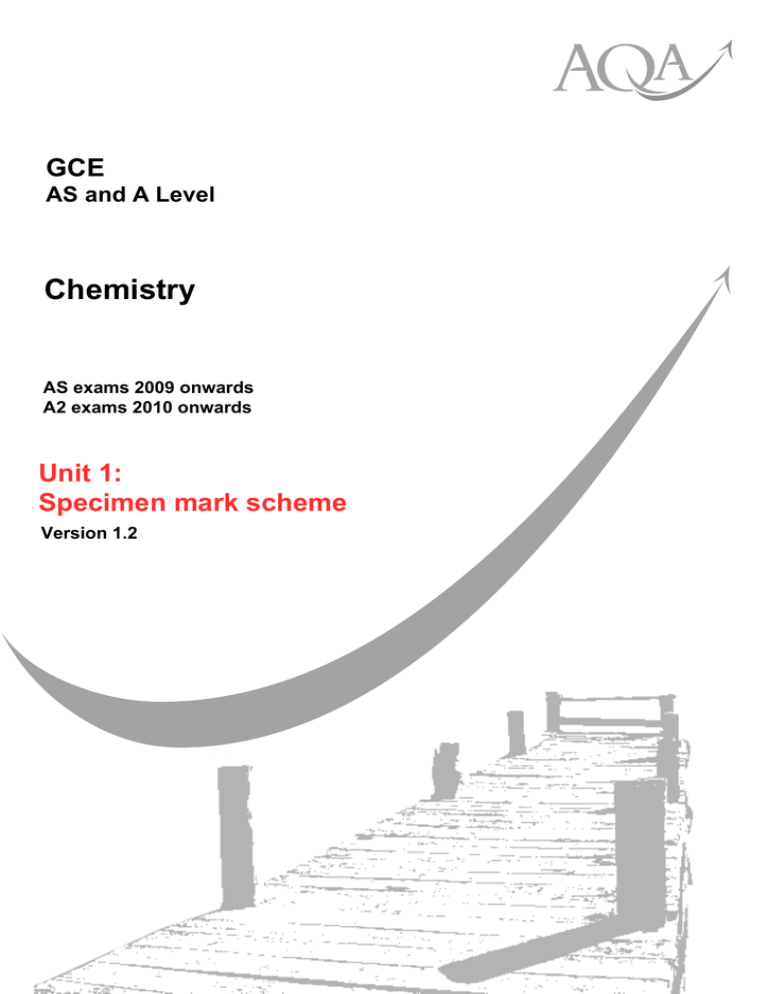
GCE
AS and A Level
Chemistry
AS exams 2009 onwards
A2 exams 2010 onwards
Unit 1:
Specimen mark scheme
Version 1.2
Version 1.2 02/09
General Certificate of Education
Chemistry 2420
CHEM1 Foundation Chemistry
Mark Scheme
Specimen Paper
Mark schemes are prepared by the Principal Examiner and considered, together with the relevant questions, by a
panel of subject teachers. The specimen assessment materials are provided to give centres a reasonable idea of the
general shape and character of the planned question papers and mark schemes in advance of the first operational
exams.
It must be stressed that a mark scheme is a working document, in many cases further developed and expanded on
the basis of candidates’ reactions to a particular paper. Assumptions about future mark schemes on the basis of one
year’s document should be avoided; whilst the guiding principles of assessment remain constant, details will change,
depending on the content of a particular examination paper.
Copyright © 2009 AQA and its licensors. All rights reserved.
COPYRIGHT
AQA retains the copyright on all its publications. However, registered centres for AQA are permitted to copy material
from this booklet for their own internal use, with the following important exception: AQA cannot give permission to
centres to photocopy any material that is acknowledged to a third party even for internal use within the centre.
Set and published by the Assessment and Qualifications Alliance.
The Assessment and Qualifications Alliance (AQA) is a company limited by guarantee registered in England and Wales (company number 3644723) and a registered charity (registered charity number 1073334).
Registered address: AQA, Devas Street, Manchester M15 6EX
Dr Michael Cresswell Director General
GCE CHEMISTRY UNIT 1 SPECIMEN MARK SCHEME/ VERSION 1.2
Question 1
(a)
Number of protons in the nucleus
(1)
(b)
They may have different numbers of neutrons
(1)
(i)
Mass spectrometer
(1)
(ii)
Mean mass of an atom × 12
Mass of 1 atom of 12C
(2)
(iii)
Ar = sum of relative m/z × rel. abundance
Total abundance
(1)
= (82×12 + 83×12 + 84×50 + 86×26)/100 = 84.16
(1)
(d)
1s2 2s2 2p6 3s2 3p6 4s2 3d10 4p6
(1)
(e)
Krypton was thought to be an inert gas (or has 8 electrons in outer shell)
(1)
Krypton has more protons than bromine
(1)
But its outer electrons are in the same shell (or have similar shielding)
(1)
Al electron is in a 3p orbital, magnesium in 3s
(1)
Energy of 3p is greater than 3s
(1)
Moles of gas produced = 3
(1)
PV=nRT
V=nRT/P = 3×8.31×298/100000
= 7.43×10-2 m3
(1)
(1)
(1)
(ii)
7.43×10-2 × 1000/298 = 0.249 m3
(1)
(i)
any two from:
(2)
(c)
(f)
(i)
(ii)
Question 2
(a)
(b)
(i)
exhaust gases hot so would boil the solution away
solution would splash
reaction might be too slow
would need continuous supply of solution and/or replacement of products
(ii)
Commercial advantage
could sell chlorine and/or hydrogen
(1)
environmental disadvantage
generation of electricity likely to lead
to release of CO2
(or chlorine toxic)
(1)
3
GCE CHEMISTRY UNIT 1 SPECIMEN MARK SCHEME/ VERSION 1.2
(c)
% O = 74%
N:O = 26/14:74/16
= 1.86: 4.63 = 1:2.5 therefore formula is N2O5
(1)
(1)
(1)
(d)
2N2O → 2N2 + O2
(1)
(e)
Proportion of O2 increased leading to higher T (or more complete
combustion)
(1)
(a)
Outer electrons are in p orbitals
(1)
(b)
decreases
Number of protons increases
Attracting outer electrons in the same shell (or similar shielding)
(1)
(1)
(1)
(c)
Sulfur molecules (S8) are larger than phosphorus (P4)
Therefore van der Waals’ forces between molecules are stronger
Therefore more energy needed to loosen forces between molecules
(1)
(1)
(1)
(d)
Argon particles are single atoms with electrons closer to nucleus
Cannot easily be polarised (or electron cloud not easily distorted)
(1)
(1)
(i)
Prevents release of toxic CO
More energy efficient (releases more energy on combustion)
(1)
(ii)
C6H14 + 6.5O2 → 6CO + 7H2O
(1)
Question 3
Question 4
(a)
Suitable product eg CO or C
Balanced equation
(iii)
Detect CO gas or C (soot or particles) in exhaust gases
(1)
CH3CH2CH2CH(CH3)2
(1)
2-methylpentane
(1)
CH3CH2CH(CH3)CH2CH3 etc
(1)
(i)
CH3CH2CH2CH=CH2
(1)
(ii)
Alumino silicate etc
(1)
(iii)
Can be made into polymers (or alcohols etc)
(1)
(b)
(c)
4
GCE CHEMISTRY UNIT 1 SPECIMEN MARK SCHEME/ VERSION 1.2
(d)
(i)
% atom economy = mass CH2Cl2/total mass reactants = 85×100/158
= 53.8%
(1)
(1)
(ii)
Because expensive chlorine is not incorperated into desired product
Raise money by selling HCl
(1)
(a) NaCl is ionic (1)
cubic lattice (1)
ions placed correctly (1)
electrostatic attraction between ions (1)
Covalent bonds between atoms in water (1)
Hydrogen bonding between water molecules (1)
Tetrahedral representation showing two covalent and two hydrogen bonds (1)
2 hydrogen bonds per molecule (1)
Attraction between ions in sodium chloride is very strong (1)
Covalent bonds in ice are very strong (1)
Hydrogen bonds between water molecules in ice are much weaker (1)
Consequently, less energy is required to break the hydrogen bonds in ice to form
separate water molecules than to break the ionic bonds in sodium chloride and make
separate ions (1)
5
GCE CHEMISTRY UNIT 1 SPECIMEN MARK SCHEME/ VERSION 1.2
(b)
Mark
Range
The marking scheme for this part of the question includes an overall assessment
for the Quality of Written Communication (QWC). There are no discrete marks
for the assessment of QWC but the candidates’ QWC in this answer will be one of
the criteria used to assign a level and award the marks for this part of the question
Descriptor
an answer will be expected to meet most of the criteria in the level descriptor
3
- claims supported by an appropriate range of evidence
- good use of information or ideas about chemistry, going beyond those given in
- the question
argument well structured with minimal repetition or irrelevant points
2
accurate and clear expression of ideas with only minor errors of grammar,
punctuation and spelling
- claims partially supported by evidence
- good use of information or ideas about chemistry given in the question but
- limited beyond this
the argument shows some attempt at structure
0-1
the ideas are expressed with reasonable clarity but with a few errors of
grammar, punctuation and spelling
- valid points but not clearly linked to an argument structure
- limited use of information or ideas about chemistry
- unstructured
- errors in spelling, punctuation and grammar or lack of fluency
4 bonding electron pairs
and one lone pair
repel as far apart as possible
QWC
lone pair - bond pair repulsion > bp—bp
QWC
pushes S-F bonds closer together
shape is trigonal bipyramidal with lone pair either axial or equatorial
QWC
angles <90
and
< 120
6
(1)
(1)
(1)
(1)
(1)
(1)
(1)
(1)

